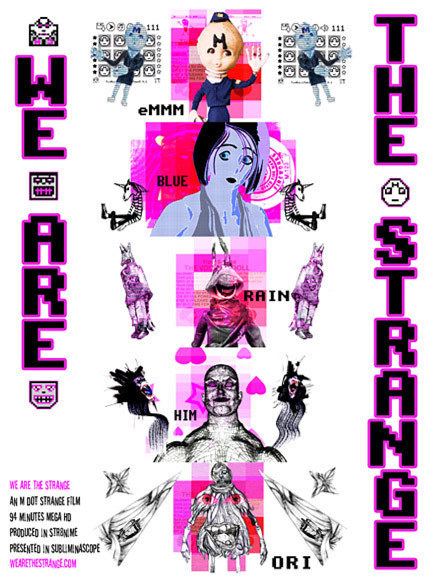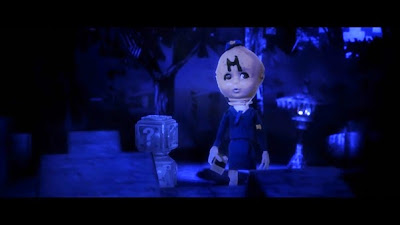Director: M dot Strange
Screenplay: M dot Strange
(Voice) Cast: David Choe as Rain;
Halleh Seddighzadeh as Blue / Prologue Narrator; M dot Strange as HIM; Stuart
Mahoney as Ori / The Pastor; Chaylon Blancett as The Wooo Monster; Benjamin
Joel Caron as Member of the Cult of the Strange; John Doremus as Sinistar; Luis
Mendoza as Red Arm; Lari Teräs as Member of the Cult of the Strange
 What do we get from internet
created work? I am not talking about work from major companies either, but
ordinary people in public who spend their time painstakingly putting together a
parody video, let alone a fully animated feature length film like We Are The
Strange which premiered at the Sundance Film Festival and whose existence
online is as much to do with its creator M dot Strange wanting to retain the
rights to his work. Secretly a lot of us probably appreciate the productions
who strain against restrictions more than some films praised by film critics;
internet culture and their access means there are probably more people who have
seen We Are the Strange than major
canonical films. Whilst this paragraph is completely with wild guesses and
conjecture which cannot be proven unless we ask every person who has seen the
film, it does have to be considered whether the internet and YouTube is now a major driving force of
entertainment, even with a project like this which is from the very early days
of this type of production being in existence. Certainly, the content and style
of the film is ahead of its time in what it is obsessed with.
What do we get from internet
created work? I am not talking about work from major companies either, but
ordinary people in public who spend their time painstakingly putting together a
parody video, let alone a fully animated feature length film like We Are The
Strange which premiered at the Sundance Film Festival and whose existence
online is as much to do with its creator M dot Strange wanting to retain the
rights to his work. Secretly a lot of us probably appreciate the productions
who strain against restrictions more than some films praised by film critics;
internet culture and their access means there are probably more people who have
seen We Are the Strange than major
canonical films. Whilst this paragraph is completely with wild guesses and
conjecture which cannot be proven unless we ask every person who has seen the
film, it does have to be considered whether the internet and YouTube is now a major driving force of
entertainment, even with a project like this which is from the very early days
of this type of production being in existence. Certainly, the content and style
of the film is ahead of its time in what it is obsessed with.
We Are the Strange is a visual creation. Set up as a story within a
video game with a character select menu, it has a stereotypical evil character
whose only goal in life is to be evil and dominate everything, a female
character named Blue who has an ailment which worsens when she talks or smiles,
a child-like doll who is supposed to be the savoir, and a mysterious stranger
and his paper clown sidekick as heroes. Truthfully, when these characters talk,
We Are the Strange slips in quality.
It is not the vocal performances, which I come to accept as M dot Strange's first film and made with
collaborators over the internet doing their hardest, but entirely because
whenever characters talk, it is usually generic clichéd dialogue and
exposition. This is clearly a film that tells a story with its visuals, which
is where the film is compelling, so when dialogue does appears it usually ends
up betrays the creator's own best gifts.
This is more so the case as this
is not a very complicated plot to follow either as it involves a stereotypical
(frankly one dimensional) villain and characters trying to stop him. Video games
have also been more complex at times, especially now but even in the past, with
their plots and complexity, but this story fits the type of aesthetic of games
which were entirely about the thrill of playing them, carried as much by the
rich and energised music through the film. This is also significant as the real
fascinating with We Are The Strange
is that it is a kinetic collage of action and images, where the dialogue (over
shaky at times) is interesting when it is part of the texture, not the
exposition to tell what the images themselves do a better job at.
The aesthetic was of immediate
interest in the first scenes. At first the independent quality stands out,
intentionally evoking games from just the immediate past in the mid to late
nineties to early 2000s, down to the motif of Sinistar from the 1983 video game
being an evil sign of warning continually in the background, and arcade
cabinets being a prop for part of the story. In knowledge that this is a
micro-budget animated film, which looks already antiquated at the time, the
hard work put into We Are the Strange
should not be dismissed considering that even if some of the character
animation is jerky at times, it also has an aesthetic which I personally love
and gets more elaborate. Any unconventional aesthetic to animation inherently
has a dream-like nature to it, and in this case the ambition is there to use
various forms as well, including stop motion.
It is rewarding and if We Are the Strange does over
complicated and confuse itself over a simplistic plot, the visual material is
rewarding. Bleak and desolate video game streets are contrasted with the added
strangeness in its motifs of aforementioned arcade cabinets being everywhere or
the obsession with ice cream. When the film rests on mood or the weird, M dot Strange gets his best work, like
an ice cream parlour that is full of human devouring monsters, the idiosyncrasies
of the creator the most interesting parts. One example, whilst the character is
a bit underused, is the paper clown, originally a kidnapping victim by the
stereotypical gruff man with no name who either went through Stockhausen Syndrome
or changed allegiances, a figure that being an "origami actor" is
made of paper and can transform himself into various shapes. These kinds of
touches are those you pluck out and see for being interesting even if skimmed
over in the midst of all the other ideas.
Beyond this, the film is pulp
which eventually leads to giant robots fighting and secret superpowers. There are
probably too many characters and ideas even for this plot, as Blue whilst the
secret heroine does not get a lot to do baring being sad, and even the plot
point that the doll child was taught from birth to pilot giant robots is one
that could have gone on longer. Nonetheless, even with this flaw and a few
others, I did find the film a reward. The dew of what would become common on YouTube, let alone video games, is here
in one film, a fascinating if sometimes difficult to follow work. The craft of
the content does have to be admired, and that M dot Strange went on to make more films to the current day is of
immense interest, suggesting what potential progression took place.
Abstract Spectrum: Kinetic/Psychotronic/Weird
Abstract Rating (High/Medium/Low/None): None



No comments:
Post a Comment